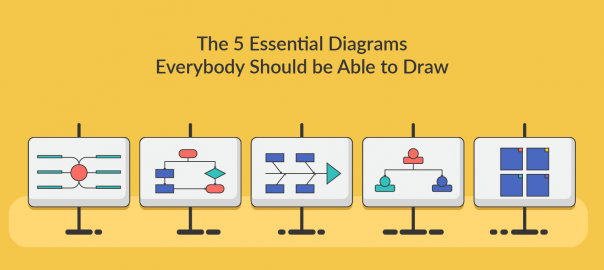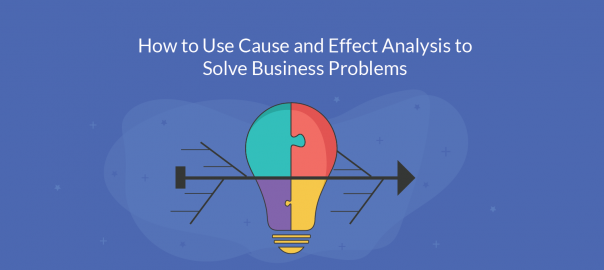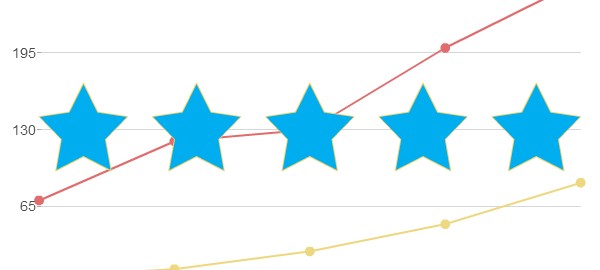Fishbone diagrams, aka Ishikawa diagrams are used across various industries to analyze causes and their effect. Because of this, they are referred to as cause and effect diagrams too. It provides a systematic approach to deeply analyze a problem when there are many possible causes. This fishbone diagram tutorial will guide you through all the important aspects of fishbone diagrams, including usages, templates and tools to draw fishbone diagrams. So let’s get started
- Definition and History of Fishbone Diagrams
- Using Fishbone Diagrams in Manufactoring
- Using Fishbone Diagrams in Marketing
- Using Fishbone Diagram in Sales Process
- Tools to draw Fishbone Diagrams
- Fishbone Diagram Templates
Definition and History of Fishbone Diagrams
Fishbone diagrams can be defined as a diagram that shows the possible causes of a specific event or a problem. They were first introduced by Kaoru Ishikawa in 1968 which is why they are sometimes referred to as Ishikawa diagrams. He pioneered the quality management processes at Kawasaki and used Ishikawa diagrams as part of the process.
Using Fishbone Diagram in Manufacturing
Whether it’s manufacturing or any other niche, the first step is to to clearly define the outcome or the effect of the analysis. Once you agree on the effect add it to the head of the diagram. Now it’s time to add the bones.
In manufacturing, the causes are usually divided into 6 main branches, commonly referred to as the 6 M’s of manufacturing. In no particular order they are
- Measurement
- Material
- Machine
- Milieu / Mother nature
- Man power
- Method
And they become the bones of your diagram as shown below.

A fishbone diagram template made for manufacturing with 6 M’s already in the branches. ( click the diagram to use it for your manufacturing processes )
The 6 Ms are the globally recognize standard, but some expand it even further to add management and maintenance to the mix. So, if it applies to your organization, you can expand the diagram and make it 8 Ms. Also if necessary, add more suitable names to the diagrams so they make more sense to others.
Once you have the basic structure, you can collaborate on the diagram as a group and identify the various causes that affect the final outcome. With a fishbone diagram, you will be able to have a visually appealing set of ideas organized by category rather than a random and sometimes even irrelevant set of ideas.
Check out this article to learn more about the process and how you can more effectively use fishbone diagrams for manufacturing.
Using Fishbone Diagrams in Marketing
Marketing is another area that can hugely benefit from a systematic fish bone diagram. It is usually an area that is somewhat harder to measure and where people have many opinions. It is important to capture those opinions and see how they impact the final outcome. And cause and effect diagrams are probably the best way to represent those ideas visually.
Like the 6 M’s in manufacturing, marketing have 7 P’s. And they are
- Product
- Place
- Price
- People
- Promotion
- Processes
- Physical evidence
And they become the bones of your diagram similar to the one shown below.

Fishbone diagram template that can be used in marketing with 7 P’s already added to the diagram( click on the image to plan your marketing activities )
All the branches shown in the diagram might not affect your marketing processes. So feel free to remove/modify branches as necessary. The key is to identify an expected outcome for problem and analyze the causes for that problem. And in marketing there are usually many problems.
Using Fishbone diagrams in Sales Process
Sales is another area where fishbone diagram can be very effective. As in marketing there is always room for improvement in the sales processes. And similar to marketing and manufacturing sales also have a set of standard categories. They are call the 5 S’s and they are
- Samples
- Schemes
- Synchronous
- Skin
- Search
Below diagram show an Ishikawa diagram template with 5 S’s already added to the bones.

Fish bone diagram template to find defects in the sales process (click on the template to modify online)
Tools and Software to Draw Fishbone Diagrams
Although individuals can use fishbone diagrams, they are much more effective when used by a team. After all, they are used to identify causes for a specific effect, so more people getting involved mean a lot more ideas.
If everyone’s in one location, then drawing a fishbone diagram in a white board and asking people to contribute ideas is a good start. This is very effective because then you can ask questions from each other or from the relevant authority and dig deep into the problem. A drawback could be that people are reluctant to come up with ideas in front of a crowd. Also there is no record for you to analyze and improve later.
Using our fishbone diagram maker, not only can you create fishbone diagrams, multiple people can collaborate on that diagram in real-time. This means you can see the changes made by each other immediately and can raise concerns then and there. All the revision are preserved so you can clearly see who made the changes and what are the changes made. Plus you have the added benefit of ability to draw many other diagram types.
Fishbone Diagram Templates to Get Started Fast
All the diagrams shown above are available as templates in Creately. Just click on any of then and you can immediately start modifying them online. But if you prefer more colorful ones or ones with some images then there are plenty more fishbone diagram examples in our diagramming community.
Got any question about this fishbone diagram tutorial? Need assistance with drawing them? Do let us know in the comments and we’ll try to answer them to the best of our ability.





Kindly inform how fish bone diagram shall be effective in finance industry keeping in aspect the customer satisfaction and service offered.
Dear Sir/Madam,
Kindly write me about “Zero- 1” ranking method for fishbone diagram . What is it and how to work?
Regards
Hemraj singh
Very Informative diagrams, Thanks a lot for sharing.